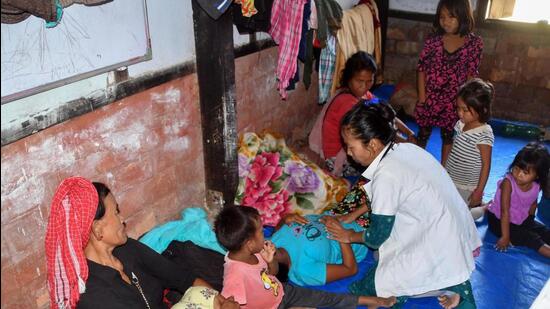
Mizoram now home: Manipur’s refugees say nothing left behind
This story first appeared in Hindustan Times
Like Mizoram, Assam’s Cachar district is playing host to 1140 residents of Manipur’s Jiribam district who crossed the border on the night of May 4
Harried and bedraggled, 45-year-old Thangma and seven members of his family arrived at a transit camp in Aizawl, Mizoram on June 18. They are from the besieged village of Suknu, a village of over 4000 in Manipur’s Kakching district. For close to a month, as ethnic violence roiled the state, Thangma’s village faced wave after wave of attack, but the family persisted. Until June 18, when they could stay no longer and fled their homes, travelling the 373 kilometre distance to Mizoram’s capital Aizawl. Now that they are here, in what is a measure of the scale of violence in Manipur, and how it affects human lives, Thangma says they will never return.
On May 27, more than three weeks after the beginning of intermittent waves of violence that have left at least 131 dead, 419 injured and 50,000 displaced, Thangma said that a group of armed men came arrived in his village, and destroyed the bridge between their village and the city of Churachandpur. The bridge was the village’s lifeline; it was through this bridge that most of the people and goods travelled to and fro. “The cut the rods on the bridge and burnt the wooden floors. That night, after our power station was also destroyed, we went to meet personnel of the Assam Rifles posted at Langching. They assured us that their men were there to protect civilians,” Thangma said.
But the next morning, the violence continued. Two groups of men, Thangma said, began torching areas in Langching, and they tried to urgently get in touch with the paramilitary men they had spoken to the previous night. There was no response. “These armed men came into our village Suknu and started looting our houses before burning them down. This happened under the nose of the (security) personnel stationed at our villages,” Thangma said.
The residents ran, and took shelter first at an Assam Rifles camp, and then a camp run by a Zo tribal youth organisation at Churachandpur. They hoped to return if things returned to a sense of calm. On June 18, with violence still continuing across Manipur, they moved to Mizoram. “I will not go home. All our homes and villages have been destroyed. With the little savings that I have, I will send my daughters to Delhi and continue my sons studies here,” Thangma said.
The populations of Mizoram and Manipur share cultural and ethnic roots, particularly among the tribals, with Kukis and Zo’s present across both states. The violence has seen many Kukis rush into Mizoram where 95 percent of the population are tribals.
From the beginning of May, Manipur has been in the throes of ethnic clashes, triggered by an order by the Manipur High Court that had recommended to the government that the Meiteis, the dominant community in Manipur with 53 % of the population, be included in the scheduled tribe list. This caused protests among the tribal population, particularly the Kukis, and tensions lead to clashes that were first concentrated in Meitei dominated Imphal Valley and districts in the hills like Churachandpur that have a heavy tribal population, but soon spread across the state. In three violent days between May 3 and 6, there was a wave of attacks and arson with people fleeing from their homes, and the army called in to control the situation. Since then however, in a sign of the simmering tension within, sporadic violence has continued, with 131 dead, over 419 injured, and over 50000 displaced from their homes.
Thangma’s family is among the 12,140 people that have fled Manipur, and relocated to Mizoram since May 3, a Mizoram home department official said. Over the past month, with people continuing to arrive, the state government and the Central Young Mizo Association(CYMA), the largest civil society organisaition in Mizoram have constructed a transit camp at the CYMA association hall in Aizawl. Lalngheta Ralte, CYMA’s president said, “Until the Government of Mizoram can establish a proper relief camp for the internally displaced persons, the Central Young Mizo Association has decided that the Central YMA Hall, located at Tuikhuahtlang, Aizawl shall be used as a transit camp.”
Once families reach the transit camp, they either stay there, or are re-routed to 11 other CYMA branches in Mizoram that have also readied halls in their respective localities.
Like Mizoram, Assam’s Cachar district is playing host to 1140 residents of Manipur’s Jiribam district who crossed the border on the night of May 4 when their homes were set on fire. Over 2200 of them arrived on that night, but over 800 have since shifted to Mizoram, with the rest being given shelter, food, water and medical support by the Assam government. One 70 year old woman, who did not want to be identified said, “We cannot return now, but we are willing to go back at some point. Whatever happens, in the end, I hope we will get our homes back,” she said.
(With inputs from Biswa Kalyan Purkayastha in Silchar)
